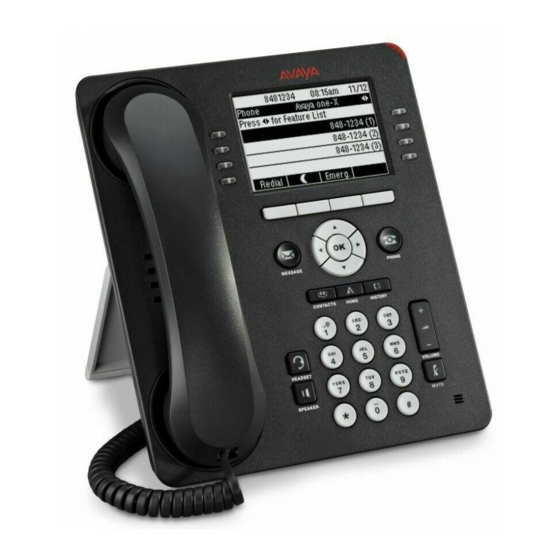About Agent status information
About agent work modes and states
When you are logged in as an agent, icons on the top two display lines and the Feature buttons
show your current work mode and state. Agent work modes are Auto-In and Manual-In. An agent
will usually have only one work mode which is either Auto-In or Manual-In as administered for the
agent. Agent states are:
Pending
You are in the Available state, but have pressed an Aux or ACW button. The Pending
state reminds you that when the call is completed, you will be placed in the Aux or
ACW state as applicable.
Aux
You are placed in the Auxiliary state after agent login. You must change to Auto-In
or Manual-In work mode to become available to receive incoming call center calls.
You can change back to Aux to indicate you are not available to receive call center
calls, for example, when you want to take a break. You must enter a Reason Code
when changing to Aux. This feature might be optional or compulsory depending on
how your system is administered.
ACW
The deskphone may automatically put you into an After Call Work (ACW ) state after
you complete each call. If you were in Manual-In mode before the call, you must re-
enter a Manual-In mode to accept another call. Switch to ACW to perform after call
work, such as completing a call-related form.
Available
You have to move to Available state through Auto-In and Manual-in feature button
when you want to handle calls.
Logged Out This state is automatically assigned when the deskphone is administered as a call
center phone but no agent sign-in has occurred. If you sign out as an agent but do
not log off the deskphone, this status is also assigned.
About status line information and icons
Icon and text
Indicated Status
Signed in, in Available mode, and with no Aux Work
for monochrome displays, or
pending.
for color displays, and the
word Available
Signed in, in Available mode, and with Aux Work or
for monochrome displays, or
After Call Work pending.
for color displays and the
word Pending
Signed in and in Aux Work mode.
for monochrome displays, or
for color displays, and the
words Aux Work
Signed in and in After Call Work mode.
for monochrome displays, or
for color displays, and the
words After Call
Signed out as an agent.
for monochrome displays, or
for color displays, and the
words Logged Out
Icon and text
Indicated Status
The VU Stats feature is active.
for monochrome displays, or
for the 9611G color
display, or
for the 9621G
and 9641G color displays.
for monochrome displays or
Incoming calls are queued up and waiting.
for the 9611G color
display or
for the 9621G
and 9641G color displays.
Forced logout override is in effect.
for monochrome displays, or
for the 9611G color display,
or
for the 9621G and
9641G color displays.
Changing agent work mode or status
Press or touch the line or feature button assigned to the work mode or work state to which you want
to change. Alternately, access the Features menu screen and select the desired work mode/state.
The associated LED flashes to indicate you are transitioning into the work mode or state you chose,
and then remains lit steadily when the selected work mode or status is active.
Answering a call
Answering a call if you are signed in as an agent
Several variables such as your call center system configuration, call delivery mode, agent status,
the number of greetings recorded determine how you answer a call.
In all cases, you are alerted to incoming calls by a special tone, the call appearance line button
flashing green in case of button-based models, or the call appearance line itself highlighted in green
for touch-based phones, and the ringing icon displayed on the incoming call's line.
Note:
If you have a touch-based deskphone (9621G or 9641G), touch the desired softkey. If you have
a button-based deskphone (9608 or 9611G), press the desired softkey. Alternate ways to using
the Answersoftkey to answer a call are to press the flashing line button for the incoming call
(button-based models) or touching the call appearance line itself (for touch-based models). Your
supervisor will advise you as to how incoming calls to the call center appear and provide any
details not covered below.
1. If you are in either Manual-In or Auto-In mode, you must always wait for an alerting signal
such as a ring or tone. Then touch or press the Answersoftkey. If Auto-Answer is enabled,
the phone generates a zip tone to alert you, and then activates the call. In either case, the
table below identifies how to answer the call depending on the type of greetings you recorded:
Recorded greeting
No greeting is recorded.
A non-Manual greeting is recorded that
matches the Type, Match Criterion, and
String to Match for the incoming call.
No non-Manual greeting is recorded that
matches the Type, Match Criterion, and
String to Match for the incoming call, but
one Manual greeting has been recorded.
Response to the greeting
Start speaking to the caller.
Listen to the greeting, and then
start speaking to the caller.
Touch or press the Greeting
softkey, listen to the greeting,
and then start speaking to the
caller.

